The Medical Gas Analyzers Market is estimated to be valued at USD 16.8 billion in 2025 and is projected to reach USD 37.3 billion by 2035, registering a compound annual growth rate (CAGR) of 8.3% over the forecast period.
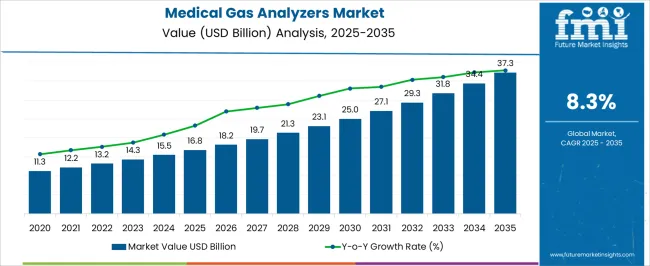
| Metric | Value |
|---|---|
| Medical Gas Analyzers Market Estimated Value in (2025 E) | USD 16.8 billion |
| Medical Gas Analyzers Market Forecast Value in (2035 F) | USD 37.3 billion |
| Forecast CAGR (2025 to 2035) | 8.3% |
The Medical Gas Analyzers market is witnessing steady growth, driven by the increasing need for accurate monitoring of medical gases across healthcare facilities. Rising investments in hospitals and healthcare infrastructure, coupled with stringent safety and regulatory standards, are fueling demand for reliable gas analyzers. The market is further supported by technological advancements in gas detection, including electrochemical sensors, infrared spectroscopy, and advanced calibration methods that enhance measurement precision and operational efficiency.
Growing emphasis on patient safety, regulatory compliance, and preventive maintenance of medical equipment is accelerating adoption. Hospitals, clinics, and diagnostic laboratories are increasingly deploying analyzers to monitor oxygen, carbon dioxide, and other medical gases in real time.
Integration with hospital management systems and automation of calibration and reporting processes is improving workflow efficiency and reducing operational risks As healthcare providers expand services and prioritize safety and quality standards, the Medical Gas Analyzers market is expected to experience sustained growth, driven by innovations in sensor technology, data integration, and multi-gas detection capabilities that enhance accuracy and reliability.
The medical gas analyzers market is segmented by type, technology, end user, and geographic regions. By type, medical gas analyzers market is divided into Single Gas Analyzers and Multiple Gas Analyzers. In terms of technology, medical gas analyzers market is classified into Electrochemical, Optical, and Infrared. Based on end user, medical gas analyzers market is segmented into Hospitals, Ambulatory Surgical Centers, Pharmaceutical Industries, and Others. Regionally, the medical gas analyzers industry is classified into North America, Latin America, Western Europe, Eastern Europe, Balkan & Baltic Countries, Russia & Belarus, Central Asia, East Asia, South Asia & Pacific, and the Middle East & Africa.
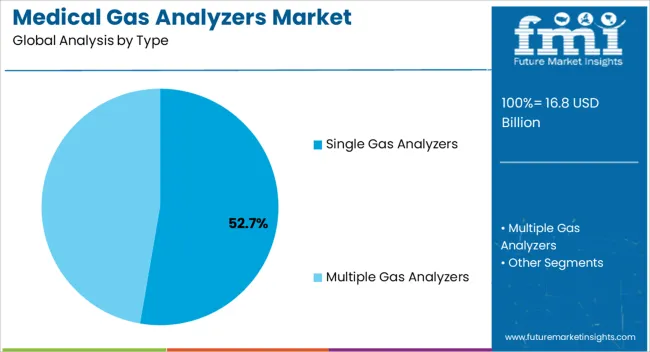
The single gas analyzers segment is projected to hold 52.7% of the market revenue in 2025, establishing it as the leading type. Its dominance is driven by the simplicity, cost-effectiveness, and reliability it provides in monitoring individual gases with high precision. These analyzers are widely adopted in hospitals, clinics, and laboratories for applications that require targeted detection of oxygen, carbon dioxide, nitric oxide, and other critical gases.
The ability to provide real-time readings and rapid alerts in case of deviations improves operational safety and compliance with healthcare standards. Calibration and maintenance procedures are straightforward, reducing operational complexity and training requirements.
The segment’s widespread adoption is further supported by affordability and scalability, allowing facilities of various sizes to implement efficient gas monitoring solutions As demand for accurate and reliable single gas detection continues to rise, the single gas analyzers segment is expected to maintain its market leadership, driven by enhanced sensor technologies, regulatory compliance requirements, and growing awareness of patient safety standards.
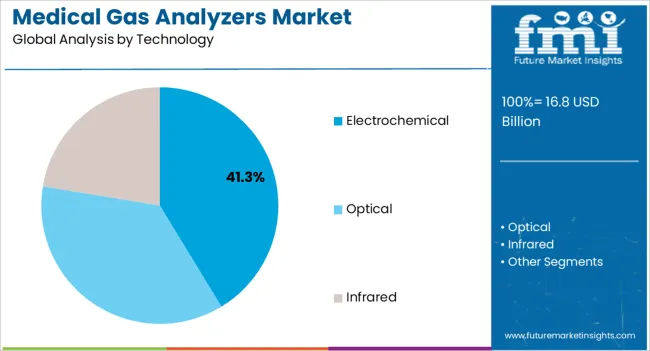
The electrochemical technology segment is anticipated to account for 41.3% of the market revenue in 2025, making it the leading technology. Growth is being driven by the high sensitivity, selectivity, and reliability of electrochemical sensors in detecting low concentrations of medical gases. These sensors provide rapid response times and stable performance, which is essential for critical healthcare applications in hospitals and laboratories.
The technology allows for compact, portable analyzer designs that can be easily deployed across multiple locations. Integration with automated monitoring and reporting systems enhances operational efficiency and ensures compliance with regulatory standards.
Electrochemical sensors are highly valued for their long-term stability, low power consumption, and minimal cross-sensitivity to other gases, supporting accurate and consistent measurements As healthcare facilities continue to expand monitoring capabilities and prioritize patient safety, the electrochemical technology segment is expected to remain the preferred choice, supported by continuous innovation in sensor design, reliability, and multi-gas compatibility.
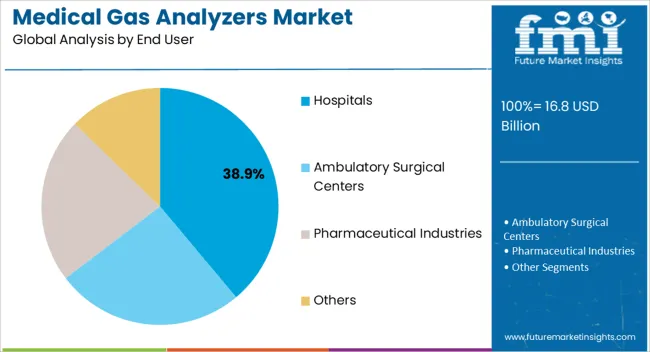
The hospitals end-user segment is projected to hold 38.9% of the market revenue in 2025, establishing it as the leading end-user category. Its growth is driven by the critical need for continuous monitoring of medical gases to ensure patient safety in surgical, intensive care, and respiratory therapy environments. Hospitals are increasingly deploying advanced analyzers to comply with regulatory standards and maintain high operational efficiency.
Integration with hospital management systems enables automated reporting, alerts, and trend analysis, reducing human error and improving decision-making. Rising adoption of modern healthcare facilities and expansion of services such as emergency care, critical care units, and diagnostic laboratories further fuels demand.
Cost-effectiveness, reliability, and ease of operation are key factors influencing preference for analyzers in hospital settings As healthcare infrastructure continues to grow and regulatory requirements become more stringent, the hospitals segment is expected to remain the primary driver of market growth, supported by advanced gas detection technologies and increased awareness of patient safety protocols.
Growing geriatric and obese populations, as well as an increase in surgical procedures worldwide, are anticipated to boost the market for medical gas analyzers
The medical equipment known as medical gas analyzers is used to quantitatively and qualitatively configure pure medicinal gases or to combine medical gases. In hospitals and healthcare facilities, gases including oxygen, nitrogen, and carbon dioxide are most frequently used. This gas analyzer will include instruments and accessories like vacuum systems, monitoring systems with alarm systems and monitors, regulators, fluidics with valves and pumps, sealing solutions, and instruments that will aid in the inspection of the concentration of medical gases.
The concentration of these gases is measured and studied after administration in the system to maintain the stability of the patient's conditions. Medical gas analyzers can be manually operated or automatically, and they use a variety of technologies, including optical, infrared, and electrochemical techniques.
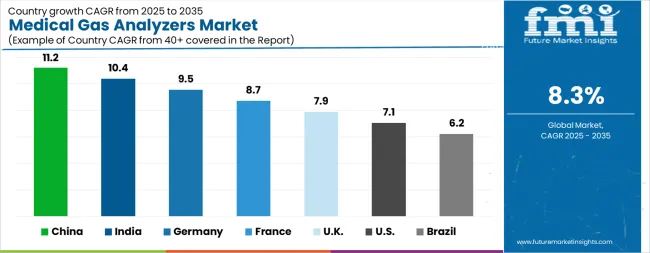
| Country | CAGR |
|---|---|
| China | 11.2% |
| India | 10.4% |
| Germany | 9.5% |
| France | 8.7% |
| UK. | 7.9% |
| USA | 7.1% |
| Brazil | 6.2% |
The Medical Gas Analyzers Market is expected to register a CAGR of 8.3% during the forecast period, exhibiting varied country level momentum. China leads with the highest CAGR of 11.2%, followed by India at 10.4%. Developed markets such as Germany, France, and the UK continue to expand steadily, while the USA is likely to grow at consistent rates. Brazil posts the lowest CAGR at 6.2%, yet still underscores a broadly positive trajectory for the global Medical Gas Analyzers Market. In 2024, Germany held a dominant revenue in the Western Europe market and is expected to grow with a CAGR of 9.5%. The USA Medical Gas Analyzers Market is estimated to be valued at USD 6.0 billion in 2025 and is anticipated to reach a valuation of USD 11.8 billion by 2035. Sales are projected to rise at a CAGR of 7.1% over the forecast period between 2025 and 2035. While Japan and South Korea markets are estimated to be valued at USD 889.8 million and USD 540.8 million respectively in 2025.
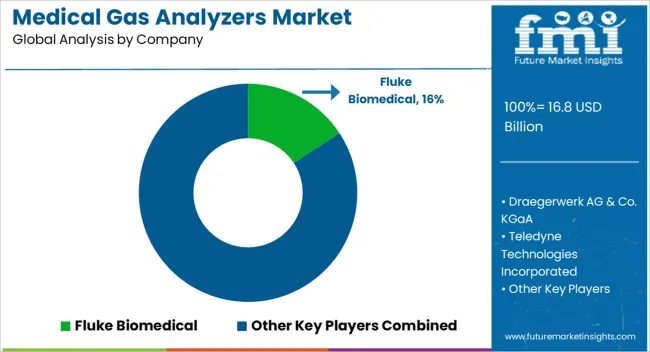
| Item | Value |
|---|---|
| Quantitative Units | USD 16.8 Billion |
| Type | Single Gas Analyzers and Multiple Gas Analyzers |
| Technology | Electrochemical, Optical, and Infrared |
| End User | Hospitals, Ambulatory Surgical Centers, Pharmaceutical Industries, and Others |
| Regions Covered | North America, Europe, Asia-Pacific, Latin America, Middle East & Africa |
| Country Covered | United States, Canada, Germany, France, United Kingdom, China, Japan, India, Brazil, South Africa |
| Key Companies Profiled | Fluke Biomedical, Draegerwerk AG & Co. KGaA, Teledyne Technologies Incorporated, Maxtec LLC, Servomex Group Ltd, Linde plc., Air Liquide, Atlas Copco, Messer, Air Products Inc., Taiyo Nippon Sanso Corporation, and Matheson Tri-Gas Inc. |
The global medical gas analyzers market is estimated to be valued at USD 16.8 billion in 2025.
The market size for the medical gas analyzers market is projected to reach USD 37.3 billion by 2035.
The medical gas analyzers market is expected to grow at a 8.3% CAGR between 2025 and 2035.
The key product types in medical gas analyzers market are single gas analyzers and multiple gas analyzers.
In terms of technology, electrochemical segment to command 41.3% share in the medical gas analyzers market in 2025.






Our Research Products

The "Full Research Suite" delivers actionable market intel, deep dives on markets or technologies, so clients act faster, cut risk, and unlock growth.

The Leaderboard benchmarks and ranks top vendors, classifying them as Established Leaders, Leading Challengers, or Disruptors & Challengers.

Locates where complements amplify value and substitutes erode it, forecasting net impact by horizon

We deliver granular, decision-grade intel: market sizing, 5-year forecasts, pricing, adoption, usage, revenue, and operational KPIs—plus competitor tracking, regulation, and value chains—across 60 countries broadly.

Spot the shifts before they hit your P&L. We track inflection points, adoption curves, pricing moves, and ecosystem plays to show where demand is heading, why it is changing, and what to do next across high-growth markets and disruptive tech

Real-time reads of user behavior. We track shifting priorities, perceptions of today’s and next-gen services, and provider experience, then pace how fast tech moves from trial to adoption, blending buyer, consumer, and channel inputs with social signals (#WhySwitch, #UX).

Partner with our analyst team to build a custom report designed around your business priorities. From analysing market trends to assessing competitors or crafting bespoke datasets, we tailor insights to your needs.
Supplier Intelligence
Discovery & Profiling
Capacity & Footprint
Performance & Risk
Compliance & Governance
Commercial Readiness
Who Supplies Whom
Scorecards & Shortlists
Playbooks & Docs
Category Intelligence
Definition & Scope
Demand & Use Cases
Cost Drivers
Market Structure
Supply Chain Map
Trade & Policy
Operating Norms
Deliverables
Buyer Intelligence
Account Basics
Spend & Scope
Procurement Model
Vendor Requirements
Terms & Policies
Entry Strategy
Pain Points & Triggers
Outputs
Pricing Analysis
Benchmarks
Trends
Should-Cost
Indexation
Landed Cost
Commercial Terms
Deliverables
Brand Analysis
Positioning & Value Prop
Share & Presence
Customer Evidence
Go-to-Market
Digital & Reputation
Compliance & Trust
KPIs & Gaps
Outputs
Full Research Suite comprises of:
Market outlook & trends analysis
Interviews & case studies
Strategic recommendations
Vendor profiles & capabilities analysis
5-year forecasts
8 regions and 60+ country-level data splits
Market segment data splits
12 months of continuous data updates
DELIVERED AS:
PDF EXCEL ONLINE
Medical Gas Cylinders Market
Blood Gas Analyzers Market Size and Share Forecast Outlook 2025 to 2035
Natural Gas Analyzers Market Size and Share Forecast Outlook 2025 to 2035
Headspace Gas Analyzers Market - Trends & Forecast 2025 to 2035
Medical Silicone Radiopaque Vascular Ties Market Size and Share Forecast Outlook 2025 to 2035
Gas Insulated Switchgear (GIS) Bushing Market Size and Share Forecast Outlook 2025 to 2035
Gas Discharge Tube (GDT) Arresters Market Size and Share Forecast Outlook 2025 to 2035
Medical Indoor Air Purifier Market Size and Share Forecast Outlook 2025 to 2035
Medical Eye Shield Film Market Size and Share Forecast Outlook 2025 to 2035
Medical Far Infrared Therapy Device Market Size and Share Forecast Outlook 2025 to 2035
Medical Latex Protective Suit Market Size and Share Forecast Outlook 2025 to 2035
Medical Activated Carbon Dressing Market Size and Share Forecast Outlook 2025 to 2035
Medical Coated Roll Stock Market Size and Share Forecast Outlook 2025 to 2035
Medical Billing Outsourcing Market Size and Share Forecast Outlook 2025 to 2035
Medical Pressure Mapping System Market Size and Share Forecast Outlook 2025 to 2035
Medical Chairs Market Size and Share Forecast Outlook 2025 to 2035
Gas & Dual-Fuel Injection Systems Market Size and Share Forecast Outlook 2025 to 2035
Medical Exoskeleton Market Forecast Outlook 2025 to 2035
Medical Display Market Forecast and Outlook 2025 to 2035
Medical Spa Market Size and Share Forecast Outlook 2025 to 2035

Thank you!
You will receive an email from our Business Development Manager. Please be sure to check your SPAM/JUNK folder too.
Chat With
MaRIA